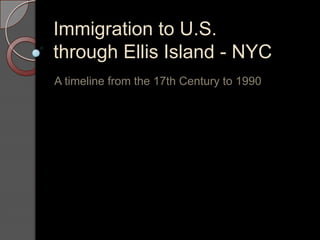
Immigration to NYC
- 1. Immigration to U.S.through Ellis Island - NYC A timeline from the 17th Century to 1990
- 2. Introduction NYC has been a principal entry point for immigration to the U.S. 18th Century: major immigration from Europe (English, German, Irish and Scandinavian). 19th Century: also Jews (Russia and eastern Europe) – 484,000 only in 1910 – and Italians, mostly. In fewer number, Greeks, Syrians, Turkish and Armenians. 1880-1920: the foreign-born population in NYC nearly tripled, from just over 700,000 to almost 2,000,000 (late) 20th Century: Asians, Hispanics and Caribbean. Today: about 36% of the city's population is foreign-born (after L.A. and Miami) and about 170 languages are spoken. Roughly 40% of the U.S. population can trace their roots through ancestors who came through Ellis Island
- 3. The 17th and 18th Centuries 1630 – Ellis Island was purchased by Colonial Governors of Nieuw Amsterdam Named Kioshk (Indian) or Gull Island – birds were the only inhabitants 1630’s – Oyster Island (Dutch man acquires the island) 1760's – Gibbet Island (pirates were hanged out) 1776 – Samuel Ellis purchases the island, builds a tavern to catering fishermen Naturalization Act (1790) – white males living in the U.S. for 2 years to become citizens Regulation for the first great wave (to come at 1814)
- 4. The 19th Century 1808 – New York State buys the island ($10,000). Military arsenal until 1890. 1850’s – 1 million Irish (potato blight) and a great number of Germans (political and economic unrest) 1847-1890: more than 10,000,000 immigrants (43 years) 1890 – $75,000 to build the 1st Federal Immigration Station on Ellis Island 01 Jan 1892 – the first Ellis Island Immigration Station was officially opened (700 immigrants that day). Nearly 450,000 immigrants this year (about 80% of the national total for U.S.) Jun 1897 – a fire destroyed most of the records (from 1840)
- 5. 1900 – 1920’s 1890-1915 – 15 million immigrants Dec 1900 – Main Building opened ($1.5 million). 2,251 immigrants that day. 1907 – peak year: 1,004,756 immigrants (71% of all those arriving in U.S.). April 17th: 11,747 immigrants. During the war, there was a sharp decline in immigration (from 178,416 in 1915 to just 28,867 in 1918 – 6 times less). 1917 – used to detain crews from German merchant ships and suspected enemies 1918-19 – used as a way station and treatment of returning sick and wounded American men.
- 6. 1920’s 1921 – post-war immigration quickly revived (560,971 immigrants) 1921 – First Immigration Quota Act: the number of any European nationality entering in a given year could not exceed 3% of foreign-born persons of that nationality who lived in the U.S. in 1910. No more than 20% of the annual quota of any nationality could be received in any given month. The total number of immigrants admissible under the system was set at nearly 358,000. 1924 – National Origins Act: further restricted immigration, changing the quota basis from the census of 1910 to that of 1890, and reducing the annual quota to some 164,000. This marked the end of mass immigration to America.
- 7. 1930’s – 1950’s 1932 – Great Depression: for the first time, more immigrants leave the country than arrive. 1946 – some 7,000 aliens and citizens (German, Italian and Japanese) were detained at Ellis Island. During the war, it was again used as a hospital for returning wounded servicemen and by the United States Coast Guard. 1950 – Internal Security Act: excluded arriving who had been members of Communist and Fascist organizations. Remodeling and repairs were performed on the buildings to accommodate detainees (1,500 at one time) 1952 – the Immigration and Naturalization Act and a liberalized detention policy dropped the number of detainees to less than 30.
- 8. 1950’s – 1990 Nov 1954 – Ellis Island was closed and declared Federal property. Total: over 40 million immigrants in 62 years. May 1965 – It was added to the Statue of Liberty National Monument. 1965 – Hart-Cellar Act: abolishes the earlier quota system, establishes the foundations for modern U.S. immigration law (more individuals from third-world countries). 1976 – Ellis Island was opened to the public for visits. 1990 – Restored and opened as a museum.
- 9. Video The story of an immigrant family (1911)
